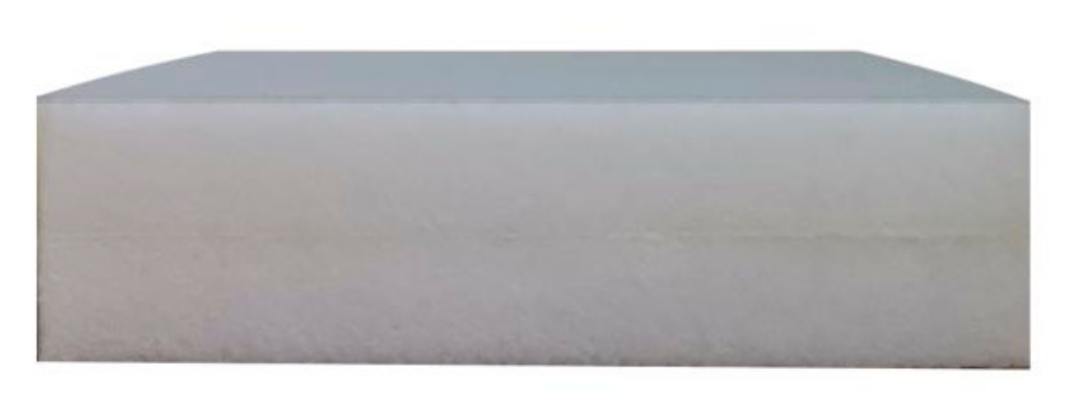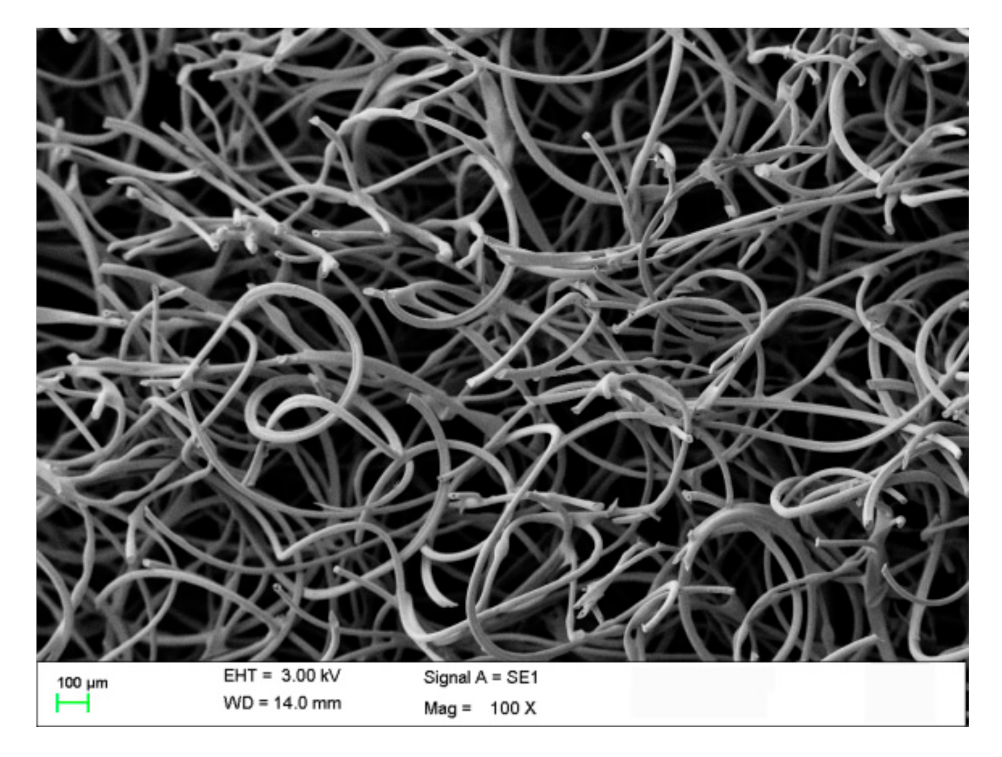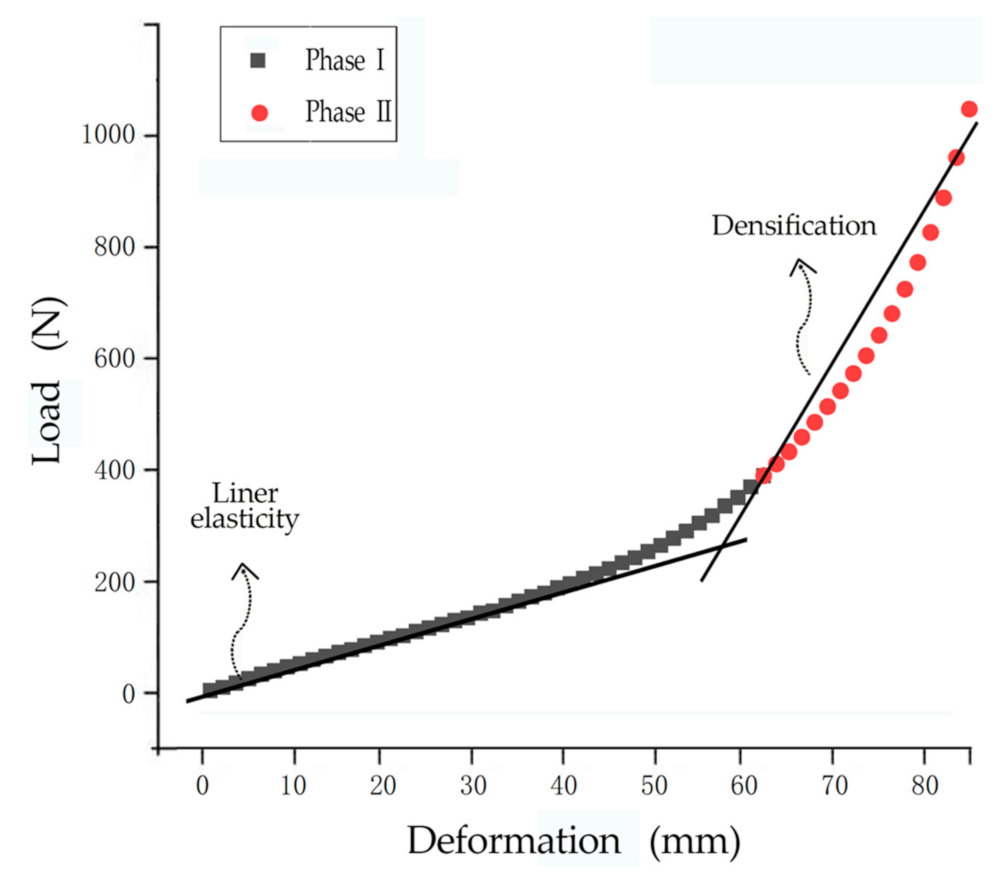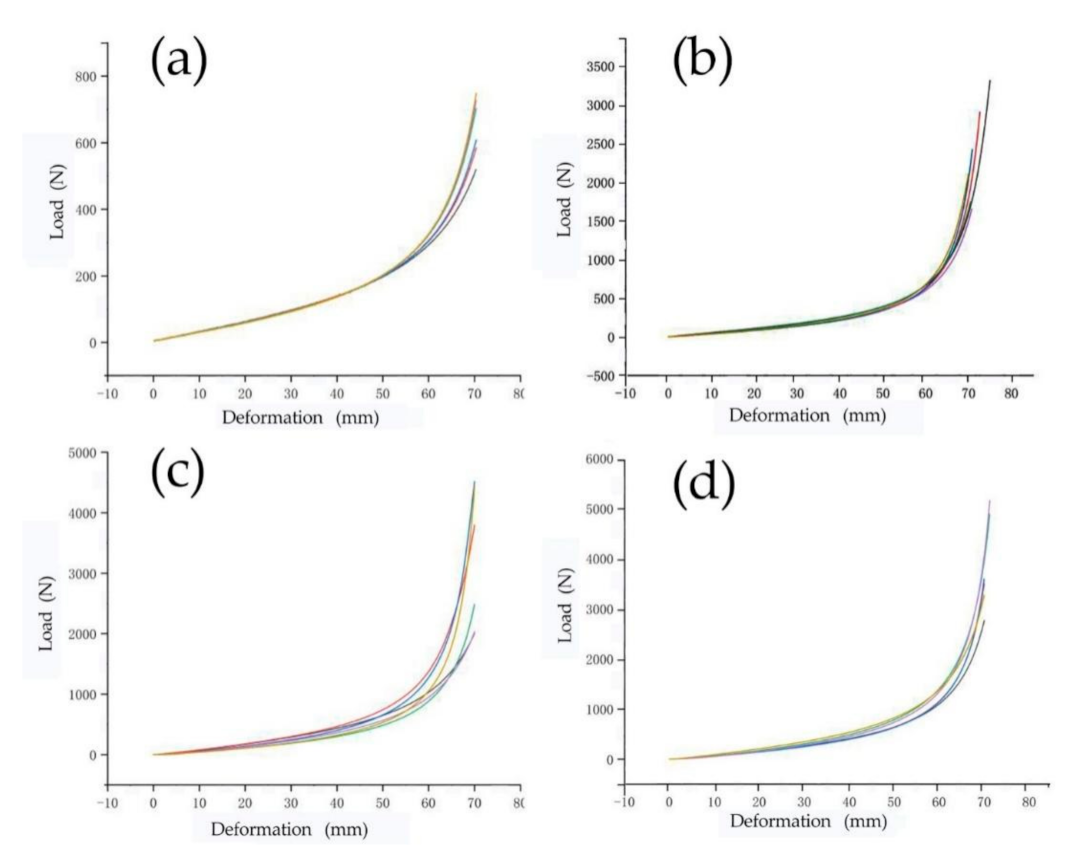Compressive Properties of Green Velvet Material Used in Mattress Bedding
Abstract
:1. Introduction
2. Materials and Methods
2.1. Materials
2.2. Methods
3. Results
3.1. Load-Deformation Curve
3.2. Indentation Force Deflection
3.2.1. The 25% Indentation Force Deflection (25% IFD)
3.2.2. The 40% Indentation Force Deflection (25% IFD)
3.2.3. The 65% Indentation Force Deflection (25% IFD)
3.2.4. Support Factor (Later Referred to as SF)
3.2.5. Initial Hardness Factor (Later Referred to as IHF)
4. Conclusions
- (1)
- The K1 value was more sensitive to density changes that range from 30 kg/m3 to 50 kg/m3 while the K2 value was sensitive to density changes that range from 20 kg/m3 to 50 kg/m3. K1 and K2 values increase along with the density, indicating that stiffness is in accordance with density. The above results indicate that a sitter would feel that the seat is significantly stiffer and have less of a sense of subsidence when sitting on a higher density PLON cushion;
- (2)
- The 25% IFD, 40% IFD, 65% IFD, SF and IHF were sensitive to density changes and significantly increase with density. The 20 kg/m3 PLON block can only supply a weaker supporting capacity. The 30 kg/m3 PLON block had a strong supporting capacity. The 40 kg/m3 and 50 kg/m3 PLON blocks had a very strong supporting capacity. The PLON that was blocked with a density of 50 kg/m3 and 40 kg/m3 had the largest SF value and strongest support ability. The 20 kg/m3 PLON block had the smallest SF value. The SF values of PLON were all significantly higher than 2.8, indicating that PLON blocks had excellent supporting properties and were considered comfortable. Density also had a significant effect on the PLON material’s IHF value. The PLON that was blocked with a density of 40 kg/m3 had the largest IHF value and the highest softness. The 50 kg/m3 and 40 kg/m3 PLON samples had equivalent softness. The 30 kg/m3 and 20 kg/m3 PLON samples had equivalent softness;
- (3)
- P30 had equivalent softness but a higher supporting capacity compared with P20. P40 had equivalent softness and supporting capacity compared with P50. In practical applications, PLON materials of 30 kg/m3 should be preferentially selected for the softer type of mattress and 40 kg/m3 should be preferentially selected for the harder type of mattress.
Author Contributions
Funding
Institutional Review Board Statement
Informed Consent Statement
Data Availability Statement
Conflicts of Interest
References
- Chao, Y.; Shen, L.M.; Liu, M.P. Mechanical characteristic and analytical model of novel air spring for ergonomic mattress. Mech. Ind. 2021, 22, 37. [Google Scholar] [CrossRef]
- Li, X.X.; Zhou, B.; Shen, L.M.; Wu, Z.H. Exploring the effect of mattress cushion materials on human-mattress interface temperatures, pre-sleep thermal state and sleep quality. Indoor Built Environ. 2020, 30, 650–664. [Google Scholar] [CrossRef]
- Li, X.; Shen, L.; Califano, R. The comparative study of thermal comfort and sleep quality for innovative designed mattress in hot weather. Sci. Technol. Built Environ. 2020, 26, 643–657. [Google Scholar] [CrossRef]
- Zhang, K.T.; Weng, B.B.; Cheng, D.; Guo, Y.; Chen, T.; Wang, L.; Wang, C.X.; Xu, R.M.; Chen, Y.X. Influence of chemical treatment and drying method on the properties of cellulose fibers of luffa sponge. Int. J. Biol. Macromol. 2021, 180, 112–120. [Google Scholar] [CrossRef] [PubMed]
- Chen, Y.; Su, N.; Zhang, K.; Zhu, S.; Zhu, Z.; Qin, W.; Yang, Y.; Shi, Y.; Fan, S.; Wang, Z.; et al. Effect of fiber surface treatment on structure, moisture absorption and mechanical properties of luffa sponge fiber bundles. Ind. Crops Prod. 2018, 123, 341–352. [Google Scholar] [CrossRef]
- Low, F.-Z.; Chua, M.C.-H.; Lim, P.-Y.; Yeow, C.-H. Effects of Mattress Material on Body Pressure Profiles in Different Sleeping Postures. J. Chiropr. Med. 2017, 16, 1–9. [Google Scholar] [CrossRef] [Green Version]
- Cheng, D.; Weng, B.; Chen, Y.; Zhai, S.; Wang, C.; Xu, R.; Guo, J.; Lv, Y.; Shi, L.; Guo, Y. Characterization of potential cellulose fiber from Luffa vine: A study on physicochemical and structural properties. Int. J. Biol. Macromol. 2020, 164, 2247–2257. [Google Scholar] [CrossRef] [PubMed]
- Kaewtatip, K.; Thongmee, J. Studies on the structure and properties of thermoplastic starch/luffa fiber composites. Mater. Des. 2012, 40, 314–318. [Google Scholar] [CrossRef]
- Chen, Y.; Su, N.; Zhang, K.; Zhu, S.; Zhao, L.; Fang, F.; Ren, L.; Guo, Y. In-Depth Analysis of the Structure and Properties of Two Varieties of Natural Luffa Sponge Fibers. Materials 2017, 10, 479. [Google Scholar] [CrossRef] [PubMed] [Green Version]
- Kim, K.-Y.; Doh, S.J.; Im, J.N.; Jeong, W.Y.; An, H.J.; Lim, D.Y. Effects of binder fibers and bonding processes on PET hollow fiber nonwovens for automotive cushion materials. Fibers Polym. 2013, 14, 639–646. [Google Scholar] [CrossRef]
- Kim, K.-Y.; Doh, S.J.; Im, J.N.; Jeong, W.Y.; An, H.J.; Lim, D.Y. Preparation of Textile Nonwoven Foams Using Elastomeric Binder Fibers for Automotive Cushioning Materials. Sen’i Gakkaishi 2013, 69, 27–33. [Google Scholar] [CrossRef] [Green Version]
- Demirel, S.; Tuna, B.E. Constant-Fatigue Performance of Different Polyurethane Foams for Sitting Purposes. Kast. Univ. J. For. Fac. 2019, 19, 225–234. [Google Scholar] [CrossRef] [Green Version]
- Demirel, S.; Tuna, B.E. Evaluation of the cyclic fatigue performance of polyurethane foam in different density and category. Polym. Test. 2019, 76, 146–153. [Google Scholar] [CrossRef]
- Hu, L.; Tor, O.; Shen, L.; Zhang, J.; Quin, F.; Yu, X. Cushioning capability analysis of seat foundations considering the sitter’s anthropometric dimensions. BioResources 2020, 15, 7992–8007. [Google Scholar] [CrossRef]
- Xu, W.; Cheng, L.L.; Yang, G.Q.; Fang, L.; Yu, N.; Wang, J.Q.; Huang, Q.T. Analysis of the Influence of Sponge Density on the Comfort of Sofa Cushion. Furniture 2018, 39, 17–21. [Google Scholar]
- Huang, L. Research on Indentation Hardness and Supporting Performance of Elastic Material of Sofa Seat. Master’s Thesis, Zhejiang Agriculture and Forestry University, Hangzhou, China, 2018. [Google Scholar]
- Yu, C.S.; Shen, L.M.; Zhao, H. The effect of mattress pad material and structure on its comprehensive rigidity. Furniture 2019, 40, 90–93. [Google Scholar]
- Chen, Y.; Zhang, K.; Guo, Y.; Yuan, F.; Zhu, Z.; Weng, B.; Dai, L.; Wu, S.; Su, N. Compression Properties of Two Novel Natural Luffa Mattress Filling Materials. J. Nat. Fibers 2019, 18, 594–606. [Google Scholar] [CrossRef]
- Gu, Y.T.; Wu, Z.H.; Zhang, J.L. Load-deflection behavior of rattan chair seats. Wood Fiber Sci. 2016, 48, 13–24. [Google Scholar]
- Zhu, Z.; Buck, D.; Guo, X.; Cao, P. High-quality and high-efficiency machining of stone-plastic composite with diamond helical cutters. J. Manuf. Process. 2020, 58, 914–922. [Google Scholar] [CrossRef]
- Zhu, Z.; Buck, D.; Cao, P.; Guo, X.; Wang, J. Assessment of Cutting Forces and Temperature in Tapered Milling of Stone–Plastic Composite Using Response Surface Methodology. JOM 2020, 72, 3917–3925. [Google Scholar] [CrossRef]
- Zhu, Z.; Buck, D.; Guo, X.; Cao, P.; Wang, J. Cutting performance in the helical milling of stone-plastic composite with diamond tools. CIRP J. Manuf. Sci. Technol. 2020, 31, 119–129. [Google Scholar] [CrossRef]
- ASTM D3574-17. Standard Methods of Testing Flexible Cellular Materials-Slab, Bonded and Molded Urethane Foams; ASTM International: West Conshohocken, PA, USA, 2017. [Google Scholar]
- Chen, B.Q.; Guan, H.Y. Application of loofah cushion filling material under the utilization of plant fiber resources. Furniture 2021, 42, 16–20,35. [Google Scholar]
- Gu, H.W. Basic Research and Optimal Design of Palm Fiber Elastic Material. Master’s Thesis, Jinan University, Guangzhou, China, 2015. [Google Scholar]






| Source | K1 | K2 | ||
|---|---|---|---|---|
| F Value | p Value | F Value | p Value | |
| PLON | 357.03 | <0.0001 | 31.54 | <0.0001 |
| Spring Constant | PLON Density (kg/m3) | LSD Values | |||
|---|---|---|---|---|---|
| 20 kg/m3 | 30 kg/m3 | 40 kg/m3 | 50 kg/m3 | ||
| K1 | 4.12 (7) C | 5.11 (9) C | 7.67 (21) B | 10.69 (21) A | 1.21 |
| K2 | 35.18 (17) D | 135.30 (28) C | 187.95 (41) B | 262.04 (37) A | 52.43 |
| Source | 25% IFD | 40% IFD | 65% IFD | SF | IHF | |||||
|---|---|---|---|---|---|---|---|---|---|---|
| F Value | p Value | F Value | p Value | F Value | p Value | F Value | p Value | F Value | p Value | |
| PLON | 29.53 | <0.0001 | 48.00 | <0.0001 | 67.07 | <0.0001 | 23.71 | <0.0001 | 8.08 | 0.0004 |
| Support Performance Indicators | PLON Density (kg/m3) | LSD Values | |||
|---|---|---|---|---|---|
| 20 kg/m3 | 30 kg/m3 | 40 kg/m3 | 50 kg/m3 | ||
| 25% IFD | 101.00 (9) C | 119.00 (11) C | 173.37 (21) B | 247.00 (22) A | 34.992 |
| 40% IFD | 173.35 (6) C | 231.18 (9) C | 356.35 (18) B | 498.23 (19) A | 59.827 |
| 65% IFD | 426.00 (7) D | 982.00 (9) C | 1648.72 (20) B | 2097.00 (17) A | 253.53 |
| SF | 4.23 (3) C | 4.49 (24) B | 9.76 (22) A | 8.60 (12) A B | 1.3587 |
| IHF | 5.84 (21) C | 6.05 (10) BC | 9.68 (32) A | 7.88 (15) A B | 1.8337 |
Publisher’s Note: MDPI stays neutral with regard to jurisdictional claims in published maps and institutional affiliations. |
© 2021 by the authors. Licensee MDPI, Basel, Switzerland. This article is an open access article distributed under the terms and conditions of the Creative Commons Attribution (CC BY) license (https://creativecommons.org/licenses/by/4.0/).
Share and Cite
Liu, Q.; Gu, Y.; Xu, W.; Lu, T.; Li, W.; Fan, H. Compressive Properties of Green Velvet Material Used in Mattress Bedding. Appl. Sci. 2021, 11, 11159. https://doi.org/10.3390/app112311159
Liu Q, Gu Y, Xu W, Lu T, Li W, Fan H. Compressive Properties of Green Velvet Material Used in Mattress Bedding. Applied Sciences. 2021; 11(23):11159. https://doi.org/10.3390/app112311159
Chicago/Turabian StyleLiu, Qingqing, Yanting Gu, Wei Xu, Tao Lu, Wenjun Li, and Haibin Fan. 2021. "Compressive Properties of Green Velvet Material Used in Mattress Bedding" Applied Sciences 11, no. 23: 11159. https://doi.org/10.3390/app112311159
APA StyleLiu, Q., Gu, Y., Xu, W., Lu, T., Li, W., & Fan, H. (2021). Compressive Properties of Green Velvet Material Used in Mattress Bedding. Applied Sciences, 11(23), 11159. https://doi.org/10.3390/app112311159





